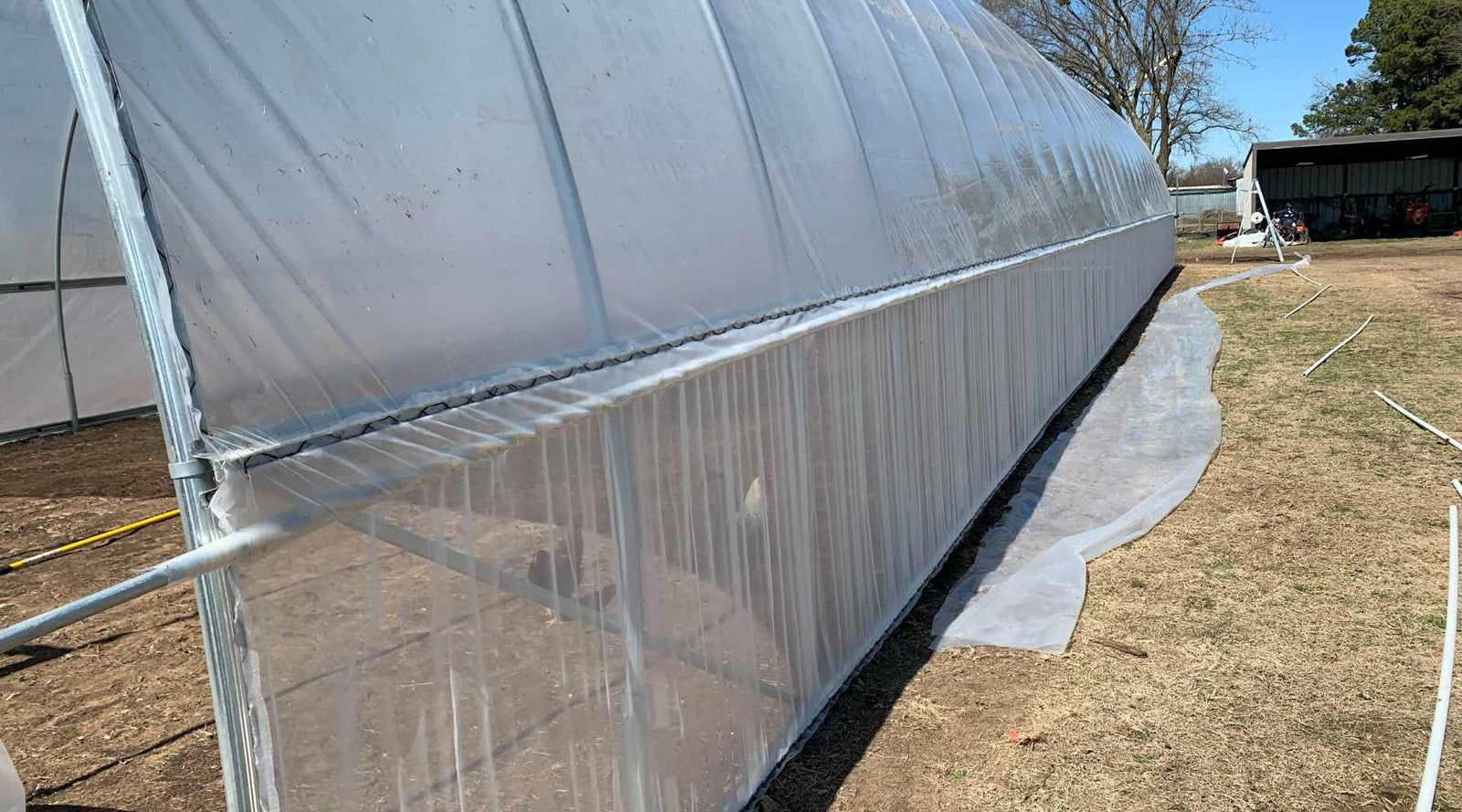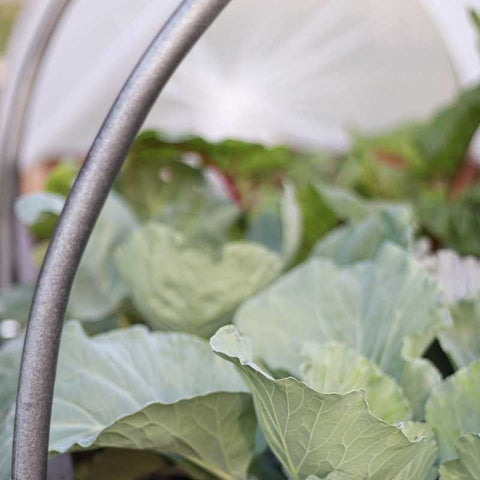Insect Netting for Pest Protection
May 14, 2023 5 min read 0 Comments

WHAT IS INSECT NETTING?
Insect netting is a protective barrier mesh usually made of woven poly. It is meant to exclude pests from valuable market crops, trees, and flowers. Pests can cause direct damage to the leaves and the fruits of crops, cause disease, and lead to lower yields.
Insect netting is designed to keep out pests, while still allowing for proper airflow and water permeability through the small mesh openings. The netting provides protection from insects, deer and rodents, and damage from excessive weather like hail.
The mesh size varies between brands and is typically chosen depending on the insect that you wish to exclude or what pests are common in your area. Mesh is measured by the number of holes in one linear inch of the netting. A common size used for row crops is between 40 and 50 mesh. Here at Bootstrap Farmer we stock a 50 mesh that is effective at excluding insects as small as 0.25 mm in size.
INSECT NETTING FEATURES
Insect netting protects plants by exclusion. Some nettings can also contain additives that help to increase their effectiveness against pests. Newer types of mesh netting can include optical additives such as aluminum strips for light reflection. Insect netting allows for increased airflow compared to plastic while still protecting plants. When using insect netting as a row cover, water from rain and overhead sprinklers is still able to reach plants.
PREVENT THRIPS FROM PENETRATING THE NETTING
The sidewall insect netting that we carry here at Bootstrap Farmer contains patented technology developed by a manufacturing process that adds various additives to the net to block and reflect UV radiation. The additives in this netting reflect and blind the insects before they can reach the netting. In addition, the mesh provides a barrier for any pests that make it past the UV barrier.
- 0.78 X 0.25 mm holes
- Optical protection
- 5 year UV resistance
- Protects against whiteflies, aphids, fruit flies and leaf miners
This type of technology acts as an added layer of defense for your plants without the use of harmful pesticides. Aluminum strips are added to netting to act as another layer of defense. The strips diffuse the light, which blinds the pests before they can penetrate the netting.
This reflective feature also cools the plants with shade and light diffusion. UV stabilizing and anti-dust additives are added to protect the netting from degradation. The same additives are also added to high-quality poly plastic greenhouse coverings.
KEEPING BENEFICIAL INSECTS IN YOUR GREENHOUSE
Insect netting can also be used to keep beneficial insects inside your greenhouse or hoop house. Some insect infestations, like spider mites and aphids, can be controlled by intentionally placing insect predators inside your growing space. Both ladybugs and green lacewing larvae are excellent at controlling infestations of soft bodied insects. However the adult form of both of these lovely and helpful predators will fly away if habitat is not ideal.
Lining any ventilation in your hoop house with insect netting will prevent the adults from flying away and keep them feeding and laying eggs where you need them. Many of the adult forms of beneficial insects require access to pollen and nectar in order to breed. If you want them to produce additional generations within your greenhouse you will need to provide this forage. To learn more about The Importance of Beneficial Insects for Your Greenhouse check out this recent article from the content team at Bootstrap Farmer.

Plant Protection for Hoop Houses and Greenhouses
Insect netting can be installed in a greenhouse using a spring and lock channel system to provide a mesh screen with a neat edge at any openings such as vents, doors, and sidewalls. It can also be used to create screen doors for additional ventilation. Covering vents with netting allows your plants to get the increased airflow they need while still being protected from pests.
Install the netting on the inside of the structure, from the baseboards to the hipboards as part of a vented sidewall for effective barrier blocks. When installed on the sidewalls, the crank will roll up the plastic to allow air flow ventilation while the screen of the mesh remains to exclude insects for plant protection. Sidewall insect netting is available in multiple lengths to fit your greenhouse size.
Protecting Row Crops with Mesh Netting
Insects weaken and damage market crops. Adding mesh insect netting into your operation's pest management program can help lower or even eliminate the need for chemical insecticides for plant protection. This means increased production levels for your farm and more perfect produce for your customers.
Netting is laid out over rows and anchored with sand bags or rocks while avoiding any gaps for insects to penetrate. While the netting is light enough to be applied directly on top of crops, row cover support hoops can be added for better results.

When should insect netting be installed?
Insect netting should be installed as early in the season as possible. This maximizes the protection while limiting the possibility of accidentally trapping insect pests in with your valuable crops.
In many cases the netting is applied as soon as the crops have sprouted or immediately after transplanting. In this way they are protected during the important vegetative growth phase and the netting can be removed once the plants begin to flower. Removing the netting as flower production begins allows for proper pollination of crops and increases the likelihood of beneficial insects arriving before pests do.
Using Insect Netting for Seed Production
Insect netting can also be used to contain pollinators and beneficial insects within a row. This is helpful for those growing for seed production as cross-pollination is less likely. In order for this to work properly it is best to create hoops that provide flying room over the crops you wish to pollinate and introduce pollinators to the covered row.
Alternatively you can cover all rows of related species except the one you wish to save seed from for a week and then switch the coverage to the row you will be saving. This helps ensure that saved seeds are less likely to be cross pollinated while you are waiting for seed heads to develop.
USING HOOPS TO INSTALL INSECT NETTING
Row cover support hoops help to keep the insect netting secure and snug on the rows. The added structure helps during the season as you are continuously removing and replacing the netting during harvest and regular weeding. They act as a guide for the netting while protecting the plants against netting snags and plant damage.
Small hoops can be made out of fiberglass or a heavy-gauge wire. They are designed to stick into the dirt on either side of the row, in an arch shape. The hoops provide structure for the netting to rest, preventing damage as the netting and the plants have a buffer. For larger scale plant protection hoops can be made from ½ inch or ¾ inch EMT tubing using one of our hoop benders. Row covers and insect netting can then be secured using our snap on clamps. Take care to bring the netting completely to the ground and anchor at the bottom with rocks, mulch or sand bags to prevent pests from sneaking in the gaps.

Cover your plants against insect damage
Using row covers like insect netting or frost blankets will help reduce plant diseases that are spread by insects as well as ensure blemish free vegetables and flowers. Applying covers at the right stage of growth will give your crops the best protection you can offer. These covers are easy to apply and can be folded away and stored during the off season for years of use. Properly used row covers make an excellent addition to your farms IPM (Integrated Pest Management) strategy. For more information on using covers on the farm read the Ultimate Guide to Ground Covers on the Farm.
Subscribe
Sign up to get the latest on sales, new releases and more …
